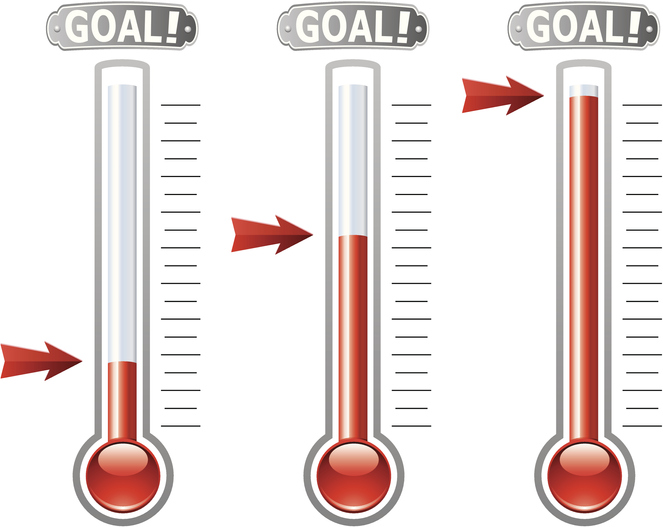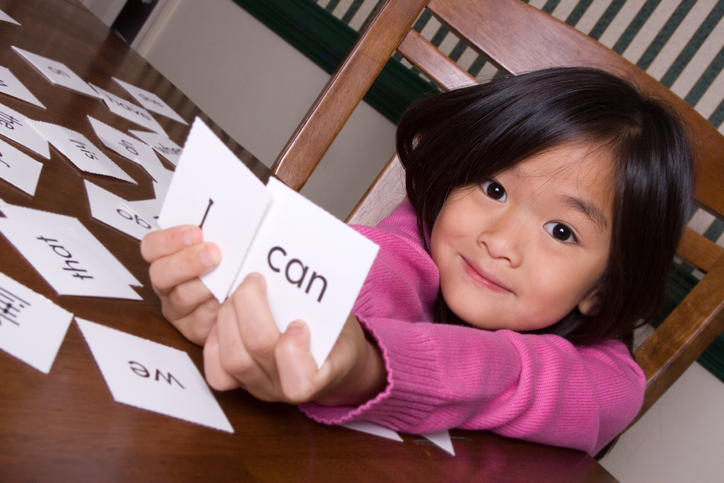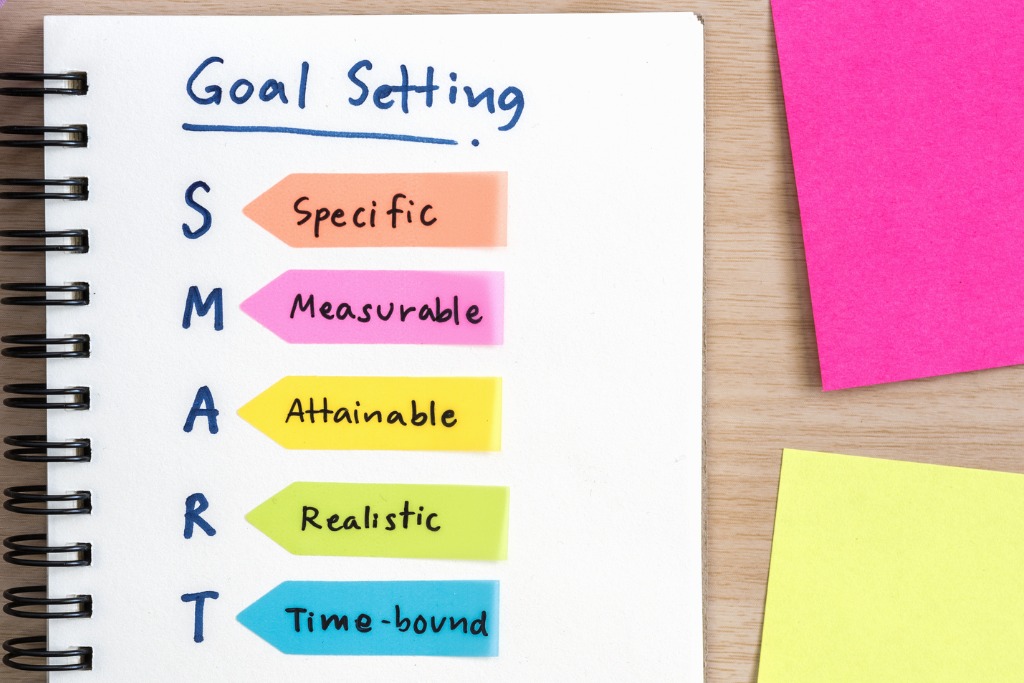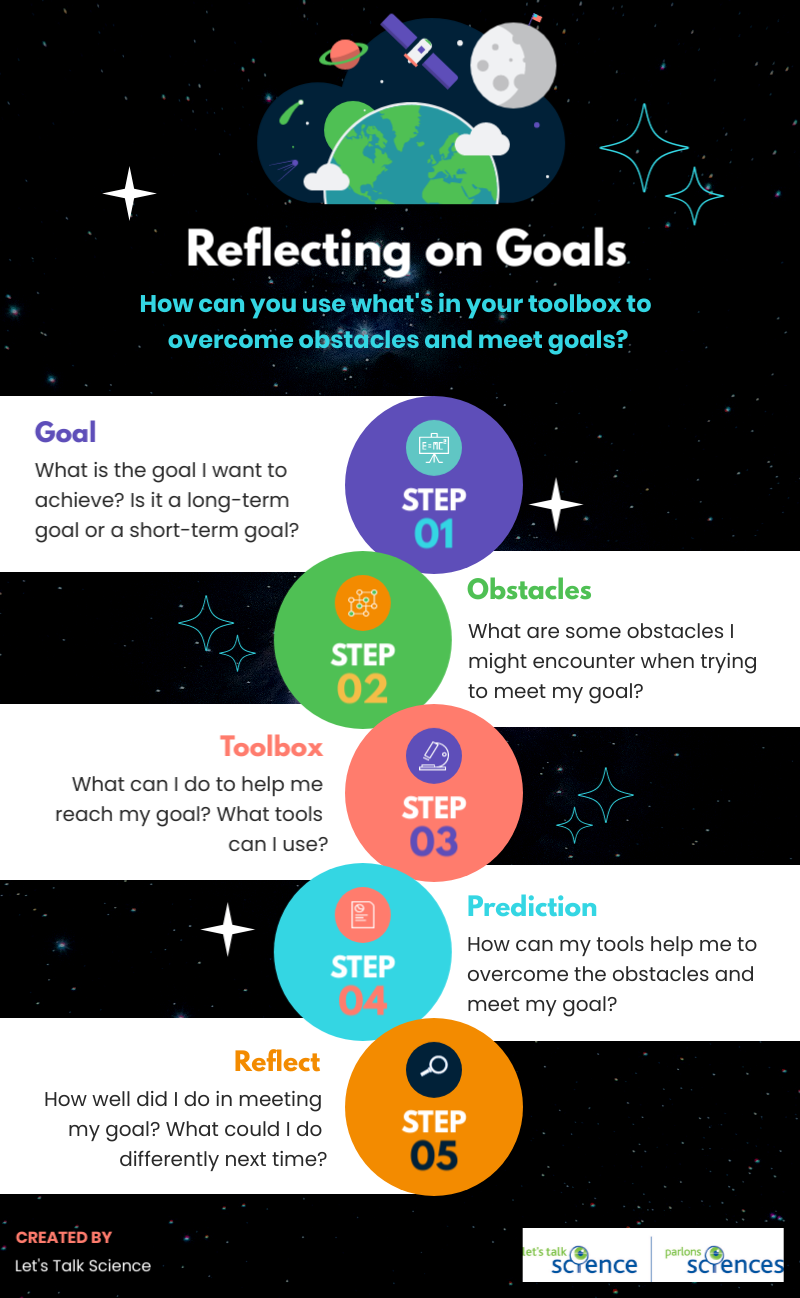Goal Setting

Feet with arrow on ground (BrianAJackson, iStockphoto)
Learn about the importance of setting goals with students and strategies for helping students set and achieve goals.
What are goals?
This may seem like an easy question. But is it? With any word or idea, it is important for everyone to have a common understanding.
A goal is a desired result that a person or group of people think about, plan, and commit to making a reality.
Sometimes the word “goal” is used interchangeably with other words such as dream, expectation or objective.
Goal ≠ Dream
Dreams can lead to goals, but are not goals themselves. Dreams tend to be based on desires and live mainly in our imagination. For example, we may dream about going to Mars or winning the lottery. Dreams can come true, but only if they are based on goals that we work hard to achieve.
Goal ≠ Expectation
Goals are also not the same as expectations. Expectations are beliefs that something will happen or be the case in the future. For example, parents might expect their children to go to university, or an athlete might expect to win a gold medal. Expectations may or may not be realistic. Not every student has the grades to get into university, even if this is what their parents expect. It may be possible to meet expectations through goal-setting and hard work!
Goal ≠ Objective
Objectives are the tasks that people accomplish in order to achieve their goals. To think about the difference, people have created the acronym G’SOT which stands for Goals, Strategies, Objectives, and Tactics.
- A GOAL is a broad outcome that one wants to achieve
- A STRATEGY is the approach one would take to achieve the goal
- An OBJECTIVE is a measurable thing one would do as part of the strategy
- A TACTIC is a tool or method one would use as part of the strategy to achieve the goal
Goals can also be classified in different ways.
Is the goal a long-term goal, such as identifying what you want to do when you retire? Or is it a short-term goal, such as identifying what activities you would like to do on an upcoming trip?
Goals can also be classified based on whether they are process or product goals. Product goals focus on the destinations and process goals focus on the journey. Product goals tend to focus on the successful completion of projects. They tend to be short-term and have fixed deadlines. On the other hand, process goals tend to focus on skill development and mastery. They are often about starting and maintaining good habits and routines and ending poor habits and routines. Process goals tend to be long-term and do not always have fixed deadlines.
Both types of goals can often be seen when students participate in sports. A student could set a product goal of completing a cross-country running event. A process goal then might be committing half an hour each day to practice running.

Students running on a gravel path outdoors (Source: FatCamera via iStockphoto).
Image - Text Version
Shown is a colour photograph of a group of students, with different skin and hair colours, running outdoors along a gravel path. The students are wearing bright coloured athletic tops and black shorts. Each student has a bib number attached to the front of their shirt. There is grass on either side of the gravel path, out of focus trees in the background, and clear skies over the horizon.
What are the benefits of setting goals?
We all know that setting goals is important, but we don’t often think about their benefits. One of the main benefits of goals is that they give us focus. Not having goals is like wandering around aimlessly. It wastes valuable time and energy. Goals give us direction, which allow us to focus our energy on what is important to us. Goals also help us measure our progress, which makes us accountable to ourselves. Knowing where we are going, how we are going to get there, and where we are along the way, can lead to increased feelings of being in control of one’s life and decreased feelings of anxiety.
Why Setting Goals is Important for Students
Students are people too, and like all people, they benefit from having goals. Learning goals, like life goals, can help students in a number of ways.
They help students stay focused
There is a lot of learning for students to do, which can at times feel overwhelming. Having goals can help students learn to focus on what is really important, and tune out less important things that compete for their time and attention. Goals are like road maps; they provide the direction students need to reach their destination.
They help students measure their progress
By setting goals, students have fixed ‘goalposts’ they are aiming for. This lets both teachers and students measure and evaluate progress. For example, if a student sets reading a whole book as a goal, then the number of pages read per day could be measured each day to demonstrate progress. And like a map, the distance to the destination can be measured.

Smiling girl reading a book (Source: SolStock via iStockphoto).
Image - Text Version
Shown is a colour photograph of a smiling young child seated in a wheelchair, holding an open book over their lap. They have long dark blond hair with bangs, and fair skin. They are wearing a mustard colour top with a ruffle bib collar, pink pants and the tops of their leg braces are visible. The child is seated in front of a solid pink background.
They help make students accountable for their learning
When students set goals for themselves, they make themselves accountable for meeting their goals. Setting their own goals and tracking progress enables students to take ownership for their learning. It also helps them to develop skills of planning, organization and time-management, and organization skills. Having clear and attainable goals also helps reduce procrastination, since the person who should be keeping the student on track is the student.
They help to motivate students
By setting goals, students give themselves a concrete endpoint to feel good about, or even get excited about! When we meet goals, we feel good about ourselves and what we have obtained. Whether it is reading an entire book or finishing a cross-country meet, seeing that it is possible to achieve what we set out to do is very rewarding. This feeling of success leads to greater self-confidence and a desire to set even more challenging goals.

Young woman feeling proud of success (Source: fizkes via iStockphoto).
Image - Text Version
Shown is a colour photograph of a young adult sitting in front of a laptop.
The person is smiling and holding arms and fists up in the air. They are seated at a patterned table. On the table is an open laptop, small indoor potted plant, and an open book. The person has brown skin, short black curly hair. They are wearing an off-white long sleeved shirt and black rimmed glasses. A furnished sitting room is out of focus in the background.
Strategies for Helping Students to Set and Achieve Goals
There are many ways to help students with goal setting. A few tips to remember include:
Start early
It’s never too early in the year to set goals. Not all goals need to be big. Setting small, obtainable goals early in the year can lead to a feeling of accomplishment that can in turn positively influence how students set and work towards larger goals.
Set goals often
One of the best ways to pursue larger goals is to break them up into smaller, more manageable goals. Many small goals feel easier to achieve than one large goal!

Students meeting goals (Source: skynesher via iStockphoto).
Image - Text Version
Shown is a colour photograph of a classroom of students with different skin and hair colours.
There are large windows letting in natural light. The young students are seated in desks connected in pairs. On the desks are a variety of school supplies including books, papers and drawing materials.
Two students in the foreground are high-fiving each other, while other students are looking down at their desks while they work.
Make it visual and relevant
Writing down measurable goals and objectives helps students to stay on track and stay motivated. Using pictures such as the yards to reach a touchdown on a football field or the temperature on a thermometer can help students visually see progress.

Goal thermometer (Source: FreeSoulArts via iStockphoto).
Image - Text Version
Shown is a colour illustration of three thermometers displayed side-by-side in a row against a white background.
Each thermometer contains a different level of red liquid. Arrows beside each point to the level of the red liquid. Above each thermometer is a plaque with the word "GOAL!" Starting from the far left, the liquid in the first thermometer reaches the 4th marker. The liquid in the second thermometer reaches between the 11th and 12th marker, and the liquid in the last thermometer reaches the top (19th) marker.
Have students use “I can” statements
When having students set goals, have them frame the goal as an “I can…” statement. For example, “I can read the whole book” or “I can run the whole cross-country course” rather than “read all of the book” or “complete the cross-country race.” These statements make goals feel personal and achievable.

Girl holding cards with the words, “I” and ,“can'' (Source: ktaylorg via iStockphoto).
Image - Text Version
Shown is a colour photograph of a young child seated in a brown chair at a brown coloured table.
The child is holding word cards with "I" and "can" in front of them with outstretched arms . There are also other word cards printed on a white background spread out on the table top.
The child has a closed-lipped smile, black hair, olive skin and is resting their chin on their long-sleeved pink knit sweater.
Use SMART goals
SMART is a popular mnemonic for setting goals. This strategy encourages students to create goals that are Specific, Measurable, Attainable/Achievable, Relevant/Realistic and Time-bound.

SMART goals written in a notebook (Source: waewkid via iStockphoto).
Image - Text Version
Shown is a colour photograph of SMART goals written in a notebook placed on a wooden table.
The words "Goal Setting" are written and underlined at the top of the page. The letters S-M-A-R-T are written vertically down the page.
Written on coloured, arrowed shaped sticky tags are what each letter stands for in the acronym SMART. S for specific, M for measurable, A for attainable, R for realistic, and T for time-bound.
Pink and yellow sticky notepads are sitting to the right of the notebook.
Specific
Specific goals have a greater chance of being achieved than a general goal. Students should consider what the goal will accomplish and why the goal is worth pursuing.
Measurable
There should be a way for the student to measure the success of each goal using tangible evidence. How will they measure whether or not the goal has been reached? Results can be measured quantitatively as well as qualitatively.
Attainable/Achievable
Goals should push students beyond their current abilities while still being achievable. This will be different for each student. While a certain goal might be attainable for one student, it might not be attainable for others.
Relevant/Realistic
Goals should make sense in the learning pathways and lives of students. For example, asking students to meet goals that require help from family members may not be realistic.
Time-bound
There should be a time frame for goals that creates a practical sense of urgency. Keep in mind that goals with deadlines that are too short can cause stress and goals with deadlines that are too far in the future can create a lack of motivation. Choosing deadlines with students is one way to overcome this issue.
This is not the only version of SMART goals out there. Inclusion education specialist Shelley Moore has another set of SMART goals that focus on strength and opportunities rather than on weaknesses and failure.
See Ya Later S.M.A.R.T Goals (2019) by Shelley Moore (6:34 min.).
Strength-based
Goals should focus on the strengths that students have which can be leveraged to meet their goals. Goals that are strength-based are often written as “I can” statements.
Meaningful
Goals that are meaningful are important to students themselves, and not just to educators. Goal setting supports the actions and skills of the Pan-Canadian Global Competencies.
Authentic
Goals that are authentic support the learning journey of the student. These are goals that connect to what is already happening in the classroom, and are not in addition to their curricular learning.
Responsive
Goals that are responsive have the ability to evolve as students move along their learning journeys. Making goals responsive ensures that the goals honour the values of the student.
Triangulated
Goals that are triangulated include methods of collecting data that are authentic and meaningful. Triangulated data comes from conversations, observations, and various products.
Have students reflect about their goals
“Setting and forgetting” can often happen with goals. This is why students should be encouraged to reflect about their goals along the way. This can include thinking in advance about the obstacles they may encounter as well as about the skills and knowledge they have in their “toolbox” that they could employ.

Reflecting on goals infographic (©2022 Let’s Talk Science).
Image - Text Version
Shown is a colour illustration of the 5 steps used to overcome obstacles and meet goals. White blocks containing coloured text are staggered on opposite sides of the image on a black background.
Step 1 Goal: What is the goal I want to achieve? Is it a long-term goal or a short-term goal?
Step 2 Obstacles: What are some obstacles I might encounter when trying to reach my goal?
Step 3 Toolbox: What can I do to help me reach my goal? What tools can I use?
Step 4 Prediction: How can my tools help me overcome the obstacles and meet my goals?
Step 5 Reflect: How well did I do in meeting my goal? What could I do differently next time?
Learn More
Two Stars and a Wish
This learning strategy could be used to help students reflect and improve upon their goals.
Used to Think, Now I Think
This learning strategy could be used to help students reflect on goals.
10 Awesome Apps for Student Goal Setting (2016)
This blog post has links to a number of different apps designed for student goal-setting.
References
Ackerman, C.E. (2019, Apr. 28) 42 Goal setting activities for students & kids (+PDF). Positive Psychology.
Belicove, M. (2013, Sep. 27) Understanding goals, strategy, objectives and tactics in the age of social. Forbes.
Ho, L. (2022, Sep. 23) What are goals? Achieve more by changing your perspectives. Lifehack.
Nordengren, C. (2019, Jul. 15) Goal setting practices that support a learning culture. Kappan.
Personality Tutor. (2012, May 17) Importance of goal setting.
Riopel, L. (2019, Jun. 14) The importance, benefits, and valve of goal setting. Positive Psychology.
Spencer, J. (2020, Dec. 28) A different way to set goals for the new year. John Spencer.